The following information is provided for reference purposes only and should be used at your own risk
In no event shall Beisan Systems, LLC or its members be liable for incidental, consequential, or special loss or damages of any kind however caused.
Introduction
“Vanos” is BMW’s name for its variable valve timing units. Vanos units take on various shapes and design according to car year and model (engine model). The vanos discussed here is BMW part # 11-36-1-404-701. It’s a double vanos; meaning the intake and exhaust valve timing is varied. This vanos unit is part of BMW 6-cylinder engine Euro S50B32. This engine was incorporated into three car models, the 3-series Euro E36 M3 93-95, Euro Z3 M Coupe 98-00, and Euro Z3 M Roadster 96-00.
This vanos, like most vanos designs, can develop a rattle. The vanos rattle is caused by wear in the variable valve timing helical (slanted) gears. These gears are found on the camshaft sprocket and splined shaft, which attaches to the vanos. The helical gear wear allows the camshaft to have lash movements that engage the splined shaft axially. At certain RPMs these movements resonate and engage axial play (free space) and cause associate components to hit and rattle. The axial play that facilitates the rattle is found on the helical gears and the splined shaft bearing. Replacing the helical gear components is expensive and the gears will wear again and the rattle will return. Removing the splined shaft bearing axial play significantly reduces the rattle to the point where it’s barely heard or not heard at all in the passenger compartment. Performance cams like the ones on this engine create stronger camshaft lash forces and thus are more susceptible to causing a rattle.
Another component that addresses the rattle is the diaphragm spring that’s incorporated in the intake and exhaust sprockets. This spring loads the sprocket rotational movement to dampen the rattle quick movements.
Over time the diaphragm spring weakens and degrades in function. Replacing the diaphragm spring with a new is often needed to fully resolve the rattle.
This diaphragm spring is not available as a separate part for the Euro S50 engines. But fortunately the same diaphragm spring is also used on the S54 and S62 engines and is available separately for these engines. On the S54 engine the part number is 11-36-7-830-684. On the S62 engine the part number is 11-36-7-833-218. But with the S62 engine BMW redesigned the diaphragm spring to thicken it. This part is more effective and lasts longer.
For an in depth discussion of the rattle cause and solution reference the Beisan single and double rattle procedure and single diaphragm spring procedure introductions.
The splined shaft bearing is made of a thick washer and two thrust (roller) bearings. The washer incorporates a stud that’s mounted to the vanos piston. The two thrust bearings sandwich the washer facilitating the splined shaft to rotate at camshaft speed without rotating the vanos piston. The washer and two thrust bearings are incased in a ring and two outer flat washers. The complete bearing is housed inside a splined shaft cavity and is closed off with a threaded cover.
Removing the splined shaft bearing axial play requires modifying or replacing one or more bearing components. The thrust bearings are a standard part and are manufactured to tight tolerances. It’s not feasible to modify or replace them. The center washer is also manufactured to a tight tolerance. The ring is a non-standard part and is manufactured to loose tolerance. It’s also made of standard steel that is annealed (soft). This is causing it to be scored by the center washer and thrust bearings. The outer flat washers reside inside the ring and thus influence the bearing axial fit. The washers are a standard bearing part, but due to their stamped manufacturing have a notable tolerance range which can significantly affect the bearing axial fit.
The ring can be replaced with a ring made of bearing steel that’s hardened and ground to bearing standards. Its height can be tightly controlled to provide a tight bearing axial fit. Standard bearing washers that have been measured and sorted can be combined to provide the needed height to provide a tight bearing axial fit. A bearing adjustment can be made at installation to address any minor axial fit variation.
The vanos rattle repair kit includes two sets of replacement bearing ring and two outer washers.
Opening the splined shaft to modify the bearing requires counter holding the splined shaft and unscrewing the cover. The splined shaft doesn”t have a built in area for grabbing it, and the cover only has two holes in it to manipulate it. The cover threads also have high strength thread locker which makes the cover very difficult to remove.
A splined shaft holder tool is needed to receive and hold the splined shaft, and a socket tool with dowels is needed to insert into the holes in the splined shaft cover and open and close it.
The vanos rattle tools includes a splined shaft holder and splined shaft socket. The holder is square and mounts in a vise and receives and counter holds the splined shaft. The socket is a standard 1/2″ drive size and has dowels that mount into the splined shaft cover holes to open and close the cover. The socket is designed to be used with an impact wrench to overcome the cover thread locker. The socket is also used with a torque wrench for final tightening.
The vanos rattle repair and rattle tool kits can be acquired through Beisan Systems (bee-saan), www.beisansystems.com/products.
Symptoms
Vanos rattle at a certain RPM range, often 1800-2200 RPM. Rattle can also occur at idle.
Repair Procedure
The following is a Euro S50 double vanos splined shaft bearing and sprocket hub diaphragm spring rattle repair procedure.
This repair should be performed with Euro S50 double vanos procedure repair.
Euro S50 Double Vanos Procedure
Repair time: 3 hours mechanic, 3+ hours DIY.
Parts, Tools, and Shop Supplies
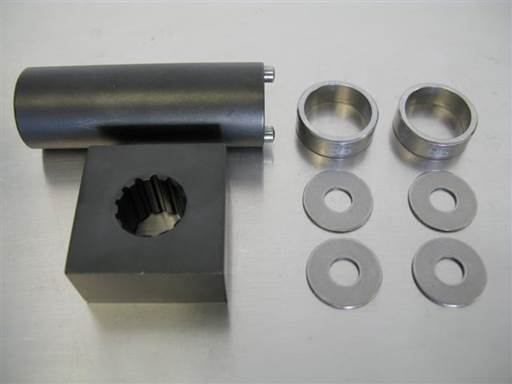
Euro S50 double vanos rattle repair kit (BS042) $80/each (www.beisansystems.com), Euro S50 vanos rattle tools (BS094) $20/each (www.beisansystems.com)

2 x S62 sprocket hub diaphragm spring and pressure plate (11-36-7-833-218) $30.89/each
Note: S62 Diaphragm spring has been redesigned to be thicker/stronger and thus better control vanos rattle. It applies to Euro S50 engine.
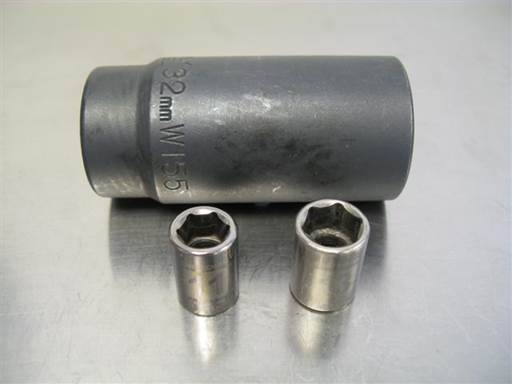
11mm socket 3/8″, 13mm socket 3/8″, 32mm deep socket 1/2″

BMW camshaft alignment bridge (83-30-0-491-085) $69.73/each, BMW camshaft alignment bridge pin (83-30-0-491-086) $23.36/each
BMW crankshaft locking pin (83-30-0-490-861) $20.86/each

4″, or larger, swivel vise
Note: Vise must be mounted for use.
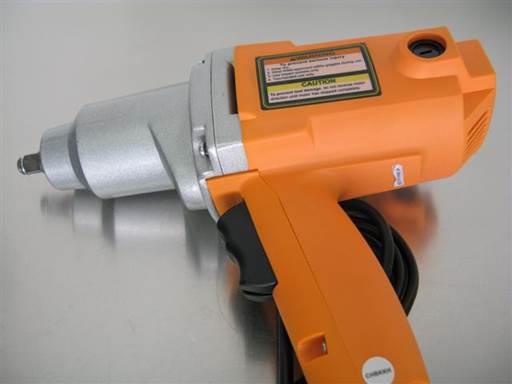
1/2″ impact wrench
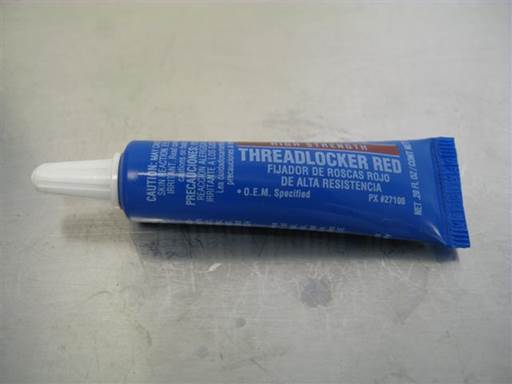
High strength thread locker (Loctite Threadlocker Heavy Duty (Euro Green, US Red), Permatex Threadlocker High Strength Red)
300-400 grit sandpaper (not shown)
Repair
Repair is performed once valve cover is removed and timing is set to TDC. Refer to Euro S50 double vanos procedure, Euro S50 Double Vanos Procedure
Removal of vanos with splined shafts
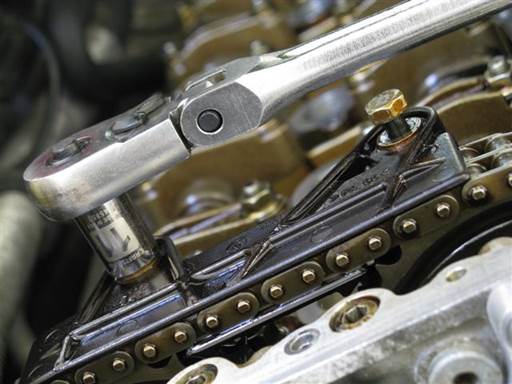
Remove chain guide.
Remove chain guide 2 mounting bolts (11mm socket 3/8″ / 3/8″ long-arm ratchet).
Slide back and remove chain guide.
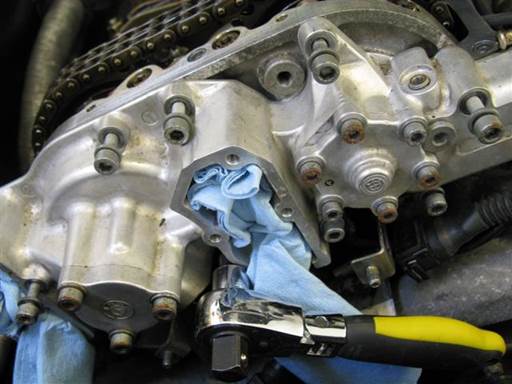
Remove vanos 9 mounting bolts; 5 upper and 4 lower (5mm hex bit socket 3/8″ / 3/8″ ratchet).
Note: Upper right and left end bolts are long. Right bolt is fully threaded and left bolt is partially threaded.
Note: Lower second bolt from right also mounts vanos ground wire.
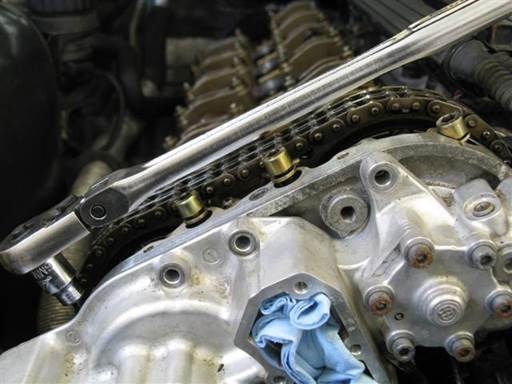
Remove vanos bridge bolts.
Remove vanos bridge 4 mounting bolts (6mm hex bit socket 3/8″ / 3/8″ long-arm ratchet).
Note: Center 2 bolts are long and outer 2 bolts are short.
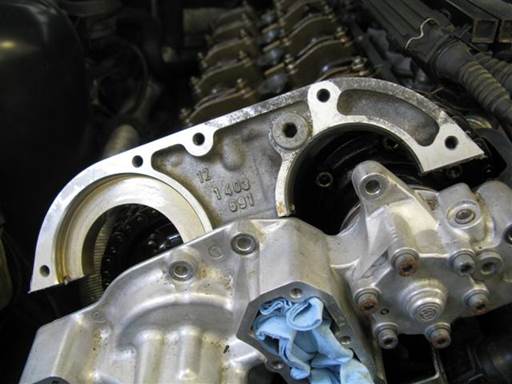
Remove vanos bridge.
Wiggle vanos bridge while pulling up to remove vanos bridge from engine head.
Note: Gasket sealant at base of bridge acts as adhesive mounting bridge to engine head. Wiggling bridge helps break sealant bond.

Do not remove first accessible intake hub mounting bolts.

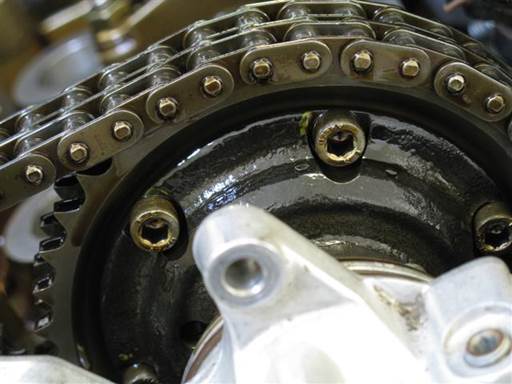
Turn crankshaft clockwise until next two intake hub mounting bolts are in accessible position (picture) (crankshaft turning socket / 1/2″ long-arm ratchet).

Remove 2 accessible intake hub mounting bolts (picture) (5mm hex bit 3/8″ / 3/8″ ratchet & extension).
Adjust crankshaft position as needed for tool access.
Note: Be careful to not drop bolts in engine.
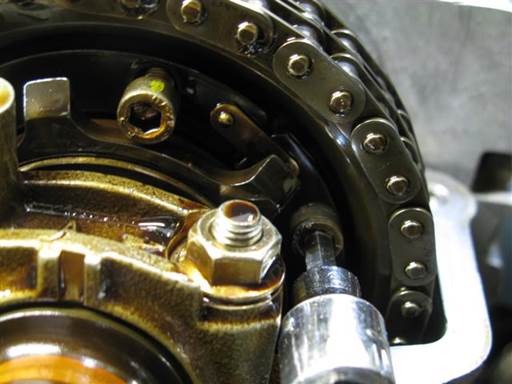
Remove 2 accessible exhaust hub mounting bolts at back of the exhaust sprocket (picture) (5mm hex bit 3/8″ / 3/8″ ratchet & extension).
Adjust crankshaft / exhaust camshaft position as needed for tool access.
Note: Be careful to not drop bolts in engine.
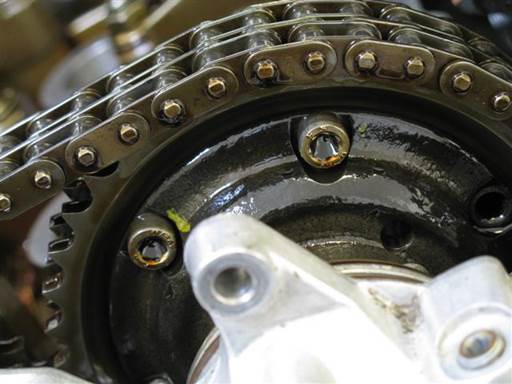
Turn crankshaft clockwise until next two intake hub mounting bolts are in accessible position (picture).
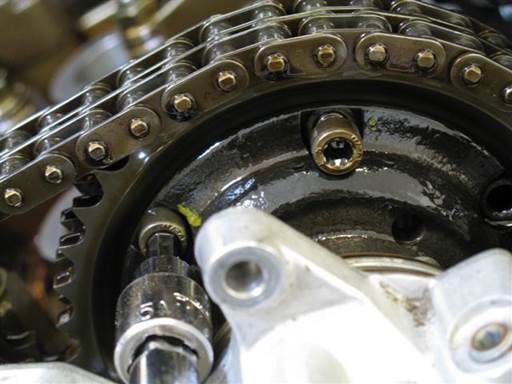
Remove 2 accessible intake hub mounting bolts (picture) (5mm hex bit 3/8″ / 3/8″ ratchet & extension).
Adjust crankshaft position as needed for tool access.
Note: Be careful to not drop bolts in engine.
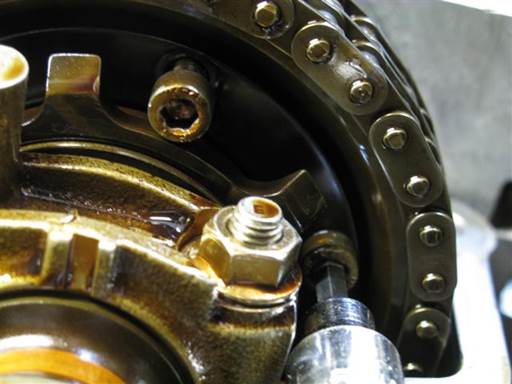
Remove 2 accessible exhaust hub mounting bolts at back of the exhaust sprocket (picture) (5mm hex bit 3/8″ / 3/8″ ratchet & extension).
Adjust crankshaft / exhaust camshaft position as needed for tool access.
Note: Be careful to not drop bolts in engine.
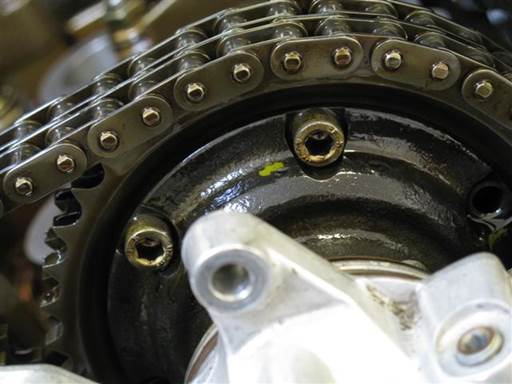
Turn crankshaft clockwise until next two intake hub mounting bolts are in accessible position (picture).

Loosen by one turn 2 accessible intake hub mounting bolts (picture) (5mm hex bit 3/8″ / 3/8″ ratchet & extension).
Adjust crankshaft position as needed for tool access.
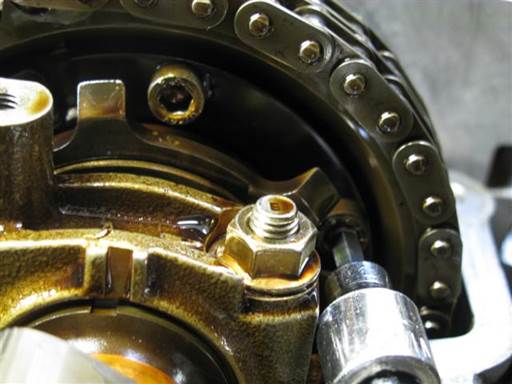
Loosen by one turn 2 accessible exhaust hub mounting bolts at back of the exhaust sprocket (picture) (5mm hex bit 3/8″ / 3/8″ ratchet & extension).
Adjust crankshaft / exhaust camshaft position as needed for tool access.
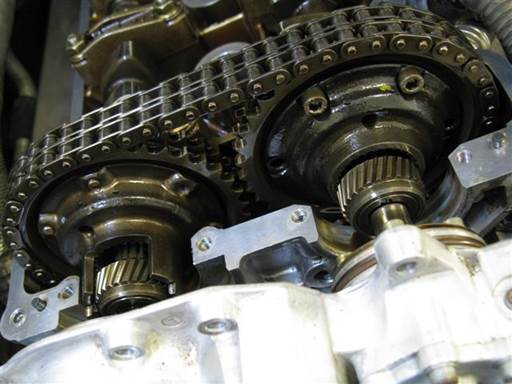
Pull and jerk vanos forward to remove with splined shafts from engine head.
As needed, pry between vanos and engine head at vanos top right and left ends to pry vanos off engine head (medium putty-knife).
Note: Vanos intake and exhaust pistons will first extend out of vanos then intake and exhaust splined shafts will come out of associate sprocket hubs.
Take vanos to work bench.
Removal of sprocket hubs
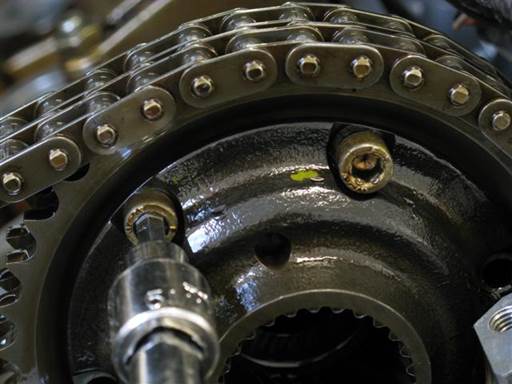
Remove 2 remaining intake hub mounting bolts (picture) (5mm hex bit 3/8″ / 3/8″ ratchet & extension).
Note: Be careful to not drop bolts in engine.
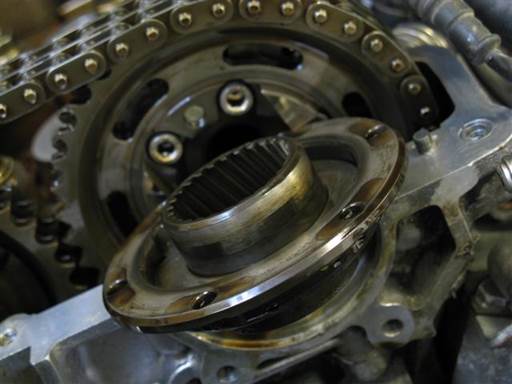
Caution: Be careful to not allow diaphragm spring and pressure plate at rear of intake hub to drop into engine when removing hub.
Pull intake hub forward slowly and press pressure plate at rear of hub into hub to prevent from dropping into engine. Pressure plate is often adhered to sprocket by oil.
Pull forward and up on hub to remove.
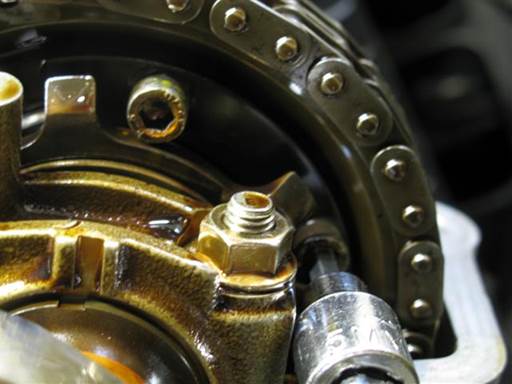
Remove 2 remaining exhaust hub mounting bolts at back of the exhaust sprocket (picture) (5mm hex bit 3/8″ / 3/8″ ratchet & extension).
Adjust crankshaft / exhaust camshaft position as needed for tool access.
Note: Be careful to not drop bolts in engine.


Adjust crankshaft slightly to align timing marks on engine timing cover and crankshaft harmonic balancer at ~11 o”clock position (crankshaft turning socket / 1/2″ long-arm ratchet, mirror).
Precisely alignment timing marks to precisely align sensor bracket hole and harmonic balancer hole (picture).
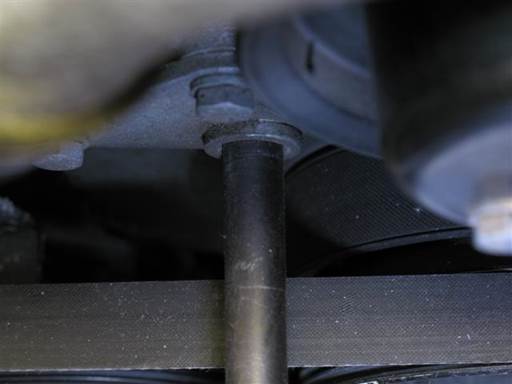
Insert crankshaft locking pin into sensor bracket hole and harmonic balancer hole.
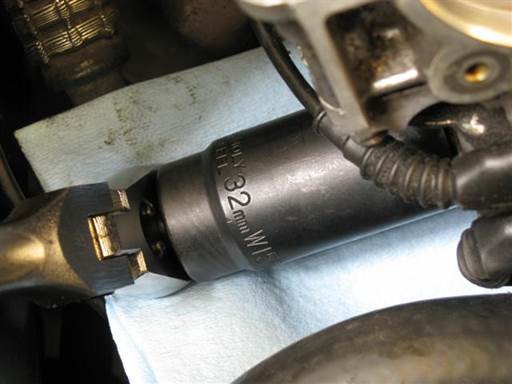
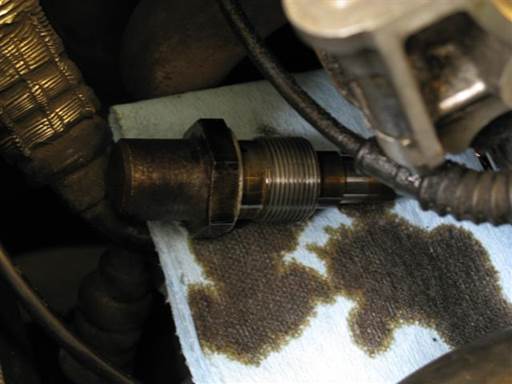
Remove chain tensioner at engine exhaust side.
Insert towel below tensioner to catch draining oil.
Remove chain tensioner (32mm deep socket 1/2″ / 1/2″ long-arm ratchet).
Remove and discard crush washer at base of chain tensioner.
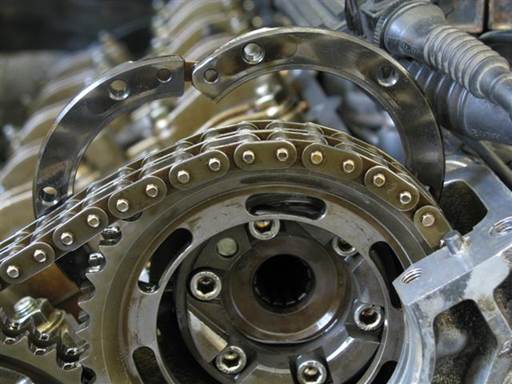
Pull forward intake sprocket to remove from sprocket sleeve.
Remove split ring at rear of sprocket.
Note: Be careful to not drop split ring into engine.

Remove intake sprocket.
Pull chain up from intake sprocket and remove intake sprocket.
Lay chain on intake camshaft.
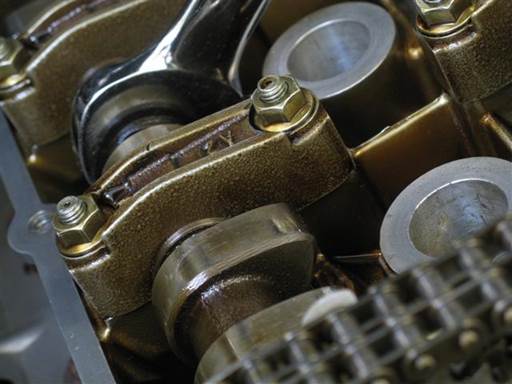
Rotate exhaust camshaft clockwise to position cylinder 1 cams to point to right and be horizontal with engine head (picture) (24mm open wrench).
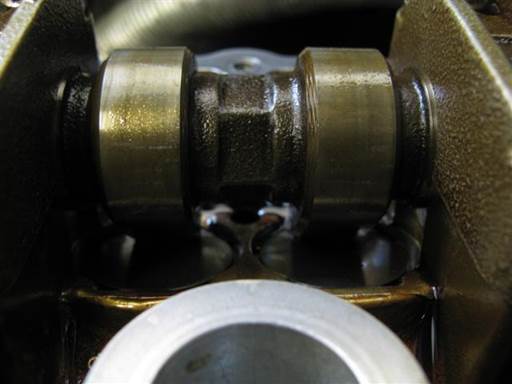

When exhaust camshaft is positioned as indicated cylinder 2 & 4 cams will be partially pressing on their corresponding valves (pictures).
Adjust exhaust camshaft to achieve this position.
Note: Indicated exhaust camshaft position assures minimal loading of exhaust valves to facilitate easy and safe removal of exhaust camshaft in next steps.


Slowly and evenly loosen exhaust sprocket 14 camshaft bearing cap mounting nuts (7 bearing caps) (13mm socket 3/8″ / 3/8″ ratchet).
Initially break seize on all nuts.
Then loosen nuts 1/4 to 1/2 turn each working back and forth along camshaft.
Ensure even nut loosening by noting threads on mounting studs and nuts. Assure even pressure on camshaft by loosening tight nuts.
Loosen nuts until all nuts have no pressure. Nuts will be almost completely removed.
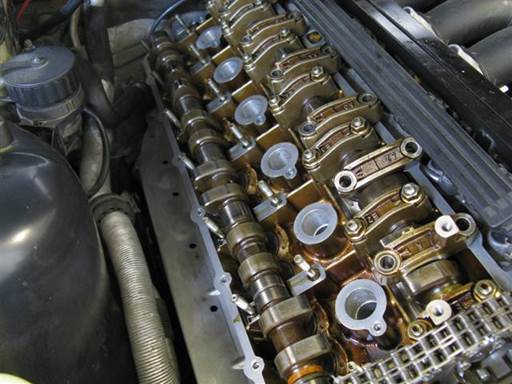
Remove bearing caps mounting nuts and bearing caps.
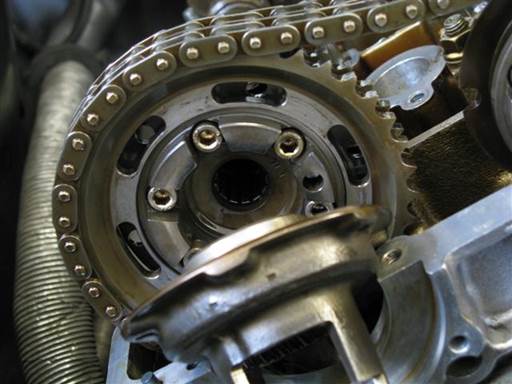
Caution: Be careful to not allow diaphragm spring and pressure plate at rear of exhaust hub to drop into engine when removing hub.
Pull up sprocket with camshaft.
Pull hub forward slowly and press pressure plate at rear of hub into hub to prevent from dropping into engine. Pressure plate is often adhered to sprocket by oil.
Pull forward and up on hub to remove.
Lower sprocket and camshaft.
Removal of splined shafts from vanos
Clean outside of vanos to remove dirt and sludge (brake cleaner & towels).
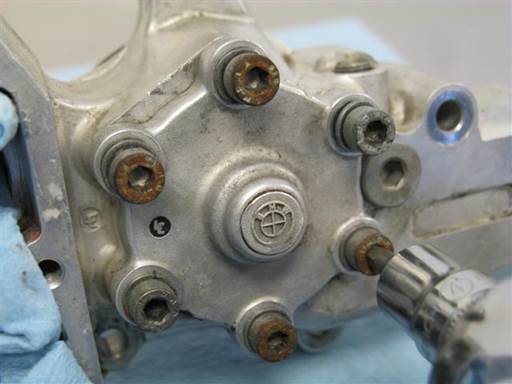
Remove vanos intake cylinder cover bolts.
Remove cover 6 mounting bolts (4mm hex bit socket 3/8″ / 3/8″ ratchet).
Note: If bolt not removed previously, paint drop will be found at bolt head base and cover. This is used in car assembly to verify bolt is fully tightened with toque wrench.

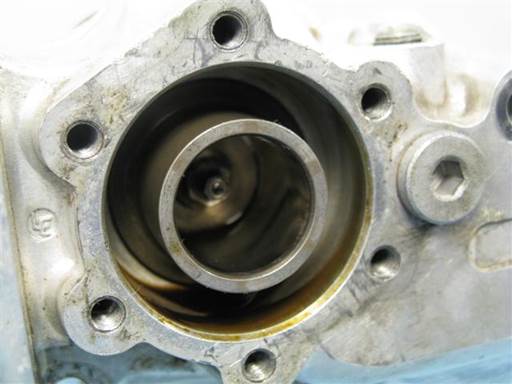
Remove intake cylinder cover.
Pry cover at multiple locations to remove cover evenly (small putty-knife).
Note: Orient blade with edge ramp side to vanos body. This orientation is more effective.
Note: Cover resistance is due to cover sealing O-ring.

Press intake splined shaft into vanos to bring piston end to cylinder end (picture).
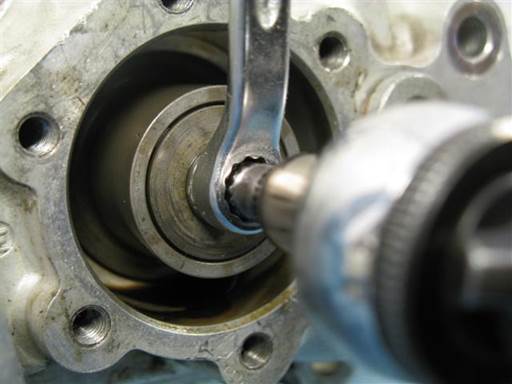
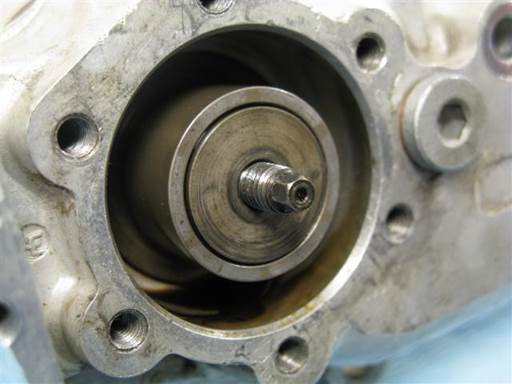
Remove vanos intake piston mounting nut.
Initially loosen nut by counter holding splined shaft stud and unscrewing nut (7mm box wrench, 4mm socket (6-point) 1/4″ / 1/4″ ratchet).
Once nut is loosened, unscrew nut by counter holding nut and screwing splined shaft stud (7mm box wrench, 4mm socket (6 point) 1/4″ / 1/4″ ratchet).
When nut is close to end of shaft and shaft can no longer be held with tool, counter hold piston/shaft by hand and unscrew nut (fingers, 7mm box wrench).
Note: It is critical 6-point socket be used, as 12-point socket is susceptible to stripping shaft hex.
Note: Be sure to use wrench box end, as open wrench is susceptible stripping nut hex.

Pull intake splined shaft out of intake piston and vanos.
Note: Removal resistance is due to splined shaft stud O-ring.

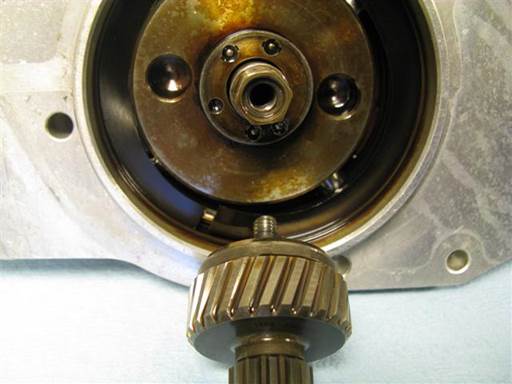
Remove vanos exhaust splined shaft from exhaust piston.
Counter hold splined shaft stud and unscrew vanos exhaust piston; left hand thread (7mm open wrench, 10mm open wrench).
Note: Piston and shaft stud are left hand thread, thus unscrew by turning piston tool (10mm open wrench) from right to left (above picture orientation).
Note: Rotate piston tool (10mm open wrench) as needed to facilitate tool access.
Installation of splined shaft rattle kit
Following procedure shows intake splined shaft but applies for both intake and exhaust splined shafts.
Removal of Splined shaft bearing
Clean splined shaft (brake cleaner & towels).
For intake splined shaft, remove O-ring at splined shaft stud center (90 degree pick).
Spray then drain cleaner through splined shaft cover holes to clear oil from bearing (brake cleaner).
Note: Removing oil from splined shaft bearing allows for bearing fit assessment in next step.

Inspect splined shaft bearing axial play.
Hold splined shaft and tilt (rock) splined shaft stud to each side to note bearing axial play (free space).
Axial play can also be checked by repeated insertion and withdrawal of stud in/out of splined shaft.
Note: Radial play, side to side movement, is normal and necessary. This should not be confused with axial play, in/out movement.

Open vise jaws as far as necessary to insert splined shaft holder.
Insert splined shaft holder in vise and align top to vise jaw top. Strongly tighten vise on splined shaft holder.
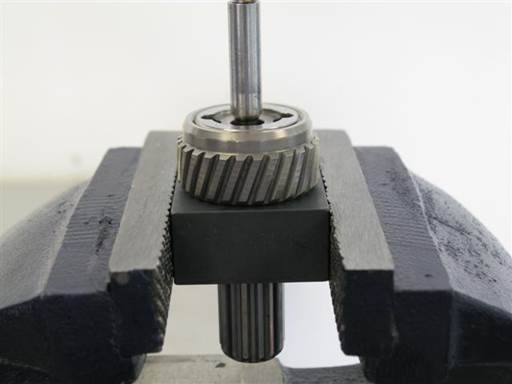
Insert splined shaft in splined shaft holder.

Install splined shaft socket on splined shaft and insert socket pins into splined shaft cover holes.
Note: Socket pins will fit tightly in splined shaft cover holes and rocking of socket might be needed to fully insert pins into holes.
Verify socket pins are fully inserted in splined shaft cover holes and socket is fully seated on splined shaft cover.

Loosen (break seize) splined shaft cover (splined shaft socket / 1/2″ impact wrench).
If available, set impact wrench power to lowest setting.
Engage impact wrench in reverse for 3 second intervals at a time until cover loosens (seize breaks).
Note: Hold down impact wrench for control.
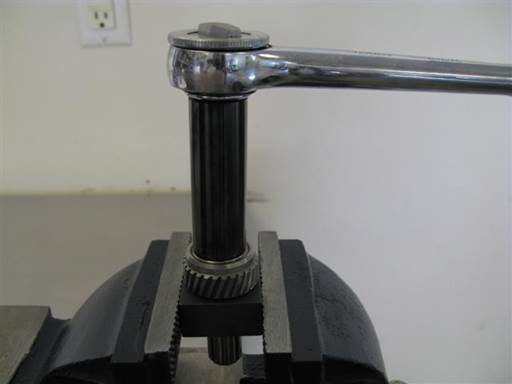
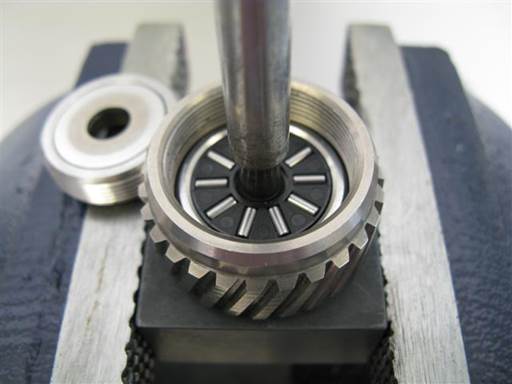
Remove splined shaft cover (splined shaft socket / 1/2″ ratchet).
Note: Splined shaft cover will turn with difficulty due to thread locker.
Bearing top washer will likely be bound to splined shaft cover inner recess and come out with cover.

Remove splined shaft center washer / stud (hand).
Note: Splined shaft stud is integral with bearing center washer.
Bearing top thrust (roller) bearing will come out with stud and center washer.

Remove bearing bottom thrust (roller) bearing.
Insert pick tip between thrust bearing inner bottom and bottom washer and pry thrust bearing out (90 degree pick).
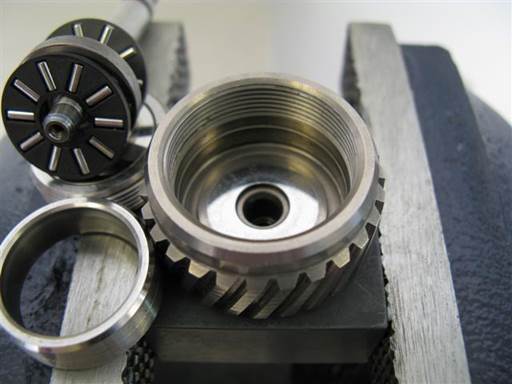
Remove bearing outer ring.
Place towel on table.
Remove splined shaft from holder, tilt upside down, and hit on towel on table.
Bearing ring will dislodge in splined shaft. Remove bearing ring with index finger.
If bearing ring tilts and binds in splined shaft, press ring down in splined shaft to remount, then reattempt removal.
Reinstall splined shaft in splined shaft holder.
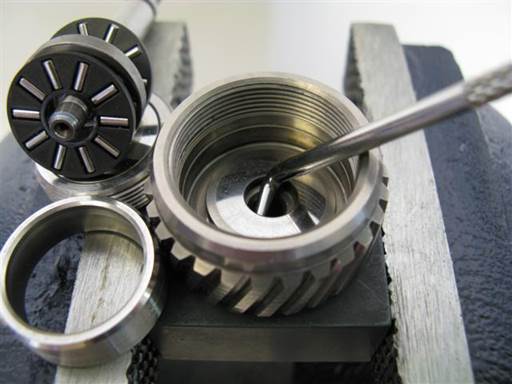
Remove bearing bottom washer.
Insert pick tip between washer inner bottom and splined shaft and pry washer out (90 degree pick).

Cleaning of splined shaft parts
Clean bearing parts (brake cleaner & towels).
Note: It is important bearing parts are thoroughly cleaned. This is needed to properly assess new bearing axial fit.
Remove old thread locker on cover and housing thread. Use pick tool to press tip into thread valley and run pick throughout thread (90 degree pick).
Note: It is critical old thread locker be fully removed to allow new thread locker to bond with parts.
Clean splined shaft bearing cavity and cover (brake cleaner & towels).
Installation of splined shaft bearing
Replace bearing ring and top and bottom washers with new parts.

Bearing parts installation sequence from right to left.
Bearing parts from left to right: Cover, top washer, top thrust bearing, center washer / stud, bottom thrust bearing, bottom washer, bearing ring.


Insert new bearing ring in splined shaft (fingers).
Note: New ring is marked “BS” on outer perimeter.
Initially insert ring in splined shaft.
Insert right and left index fingers into ring. Press fingers against ring inner right and left walls and manipulate ring side to side while slightly pressing down to facilitate ring full insertion.
Rotate position of fingers 90 degrees and repeat ring insertion to verify full insertion.
Note: Ring should fully mate with splined shaft bottom (picture).
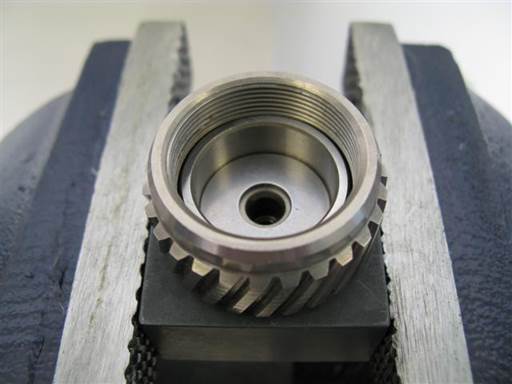
Insert bearing bottom washer in splined shaft bearing ring.
Note: Splined shaft bearing top and bottom washers are interchangeable. Also washer faces are same thus washer can be inserted in either orientation.
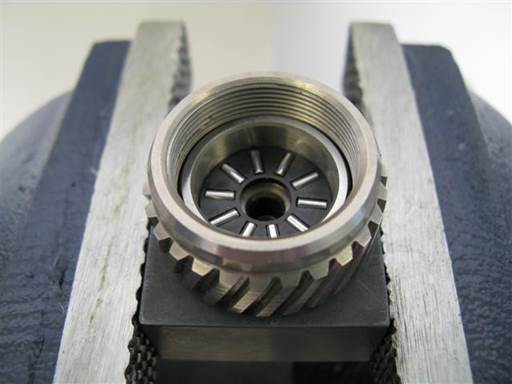
Insert bearing bottom thrust (roller) bearing in splined shaft bearing ring.
Note: Splined shaft bearing top and bottom thrust bearings are interchangeable. Also thrust bearing faces are functionally same thus thrust bearing can be inserted in either orientation.
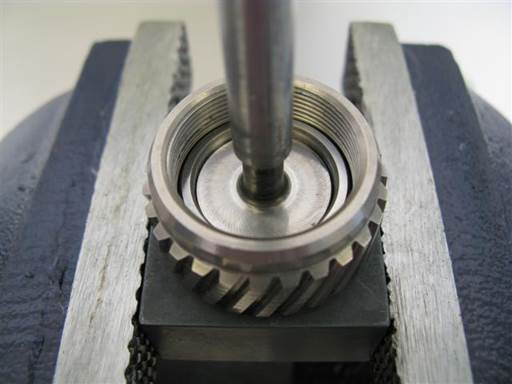
Insert bearing center washer / stud in splined shaft bearing ring.

Insert bearing top thrust (roller) bearing onto splined shaft stud and in splined shaft bearing ring.
Note: Thrust bearing faces are functionally same thus thrust bearing can be inserted in either orientation.
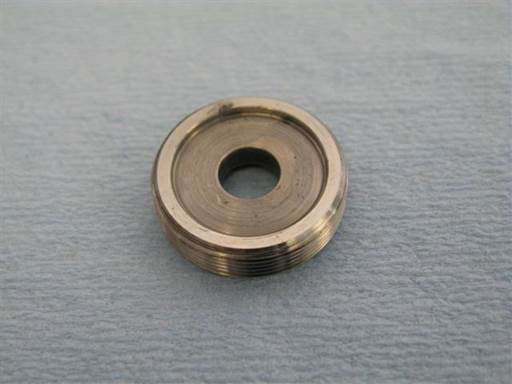
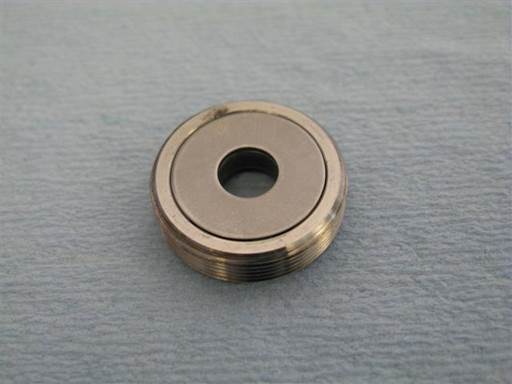
Insert bearing top washer in splined shaft cover inner cavity.
Apply some oil to splined shaft cover inner cavity.
Insert bearing top washer in cover cavity.
Note: Washer will bind to cover due to oil.
Note: Mounting bearing top washer to cover inner cavity allows for cover installation without bearing top washer interference.

Install splined shaft cover with bearing top washer onto splined shaft (splined shaft socket / 1/2″ ratchet).

When splined shaft cover is fully installed its top will be even with splined shaft rim (picture).
If cover is higher than splined shaft rim then bearing parts are not installed correctly and interfering with cover installation. Remove cover and reinstall bearing parts.

Fully tighten splined shaft cover, 55 Nm (40.5 ft-lb) (splined shaft socket / 3/8″ torque wrench & 3/8″ to 1/2″ socket adapter).
Inspection and adjustment of splined shaft bearing
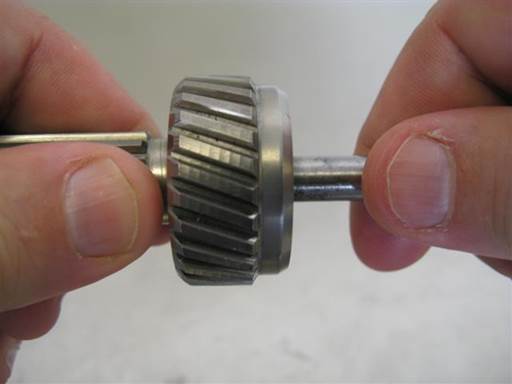
Inspect splined shaft bearing axial play.
Hold splined shaft and rotate splined shaft stud to note resistance to rotation.
Hold splined shaft and tilt (rock) splined shaft stud to each side to note bearing axial play (free space).
Note: Axial fit cannot be properly assessed until splined shaft cover is fully tightened.
Note: Radial play, side to side movement, is normal and necessary. This should not be confused with axial play, in/out movement.
If splined shaft stud binds and is difficult to rotate then axial fit is too tight and loosening adjustment is needed.
If splined shaft stud has any tilt movement then axial play is present and tightening adjustment is needed.
Any level of resistance (pre-load), without binding, in splined shaft stud rotation indicates no axial play and is considered an optimal fit.

Bearing loosening adjustment.
If splined shaft binds and is difficult to rotate then axial fit it too tight and loosening adjustment is needed.
Disassemble splined shaft bearing per above procedure.
Place sandpaper (300-400 grit) on flat table top. Place bearing outer washer on sandpaper.
Slide washer side to side on sandpaper ~6″ back and forth while moderately pressing washer on sandpaper. Perform sanding for 10 seconds.
Rotate washer 90 degrees and repeat sanding process.
Flip washer to opposite side and repeat above sanding procedure; 10 seconds sanding, rotate 90 degrees, 10 seconds sanding.
Clean washer (brake cleaner & towels).
Repeat washer sanding for second outer washer.
Reassemble splined shaft bearing per above procedure and reassess bearing axial fit.
Note: Washers are made from hardened steel and do not easily wear. Sanding procedure will remove ~.0025mm washer height, total ~.005. Washers might need max .01mm height adjustment.

Bearing tightening adjustment.
If splined shaft has any tilt movement then axial play is present and tightening adjustment is needed.
Disassemble splined shaft bearing per above procedure.
Place sandpaper (300-400 grit) on flat table top. Place bearing ring on sandpaper.
Slide ring side to side on sandpaper ~6″ back and forth while moderately pressing ring on sandpaper. Perform sanding for 5 seconds.
Rotate ring 90 degrees and repeat sanding process.
Flip ring to opposite side and repeat above sanding procedure; 5 seconds sanding, rotate 90 degrees, 5 seconds sanding.
Clean ring (brake cleaner & towels).
Reassemble splined shaft bearing per above procedure and reassess bearing axial fit.
Note: Ring is made from hardened steel and does not easily wear. Sanding procedure will remove ~.005mm ring height. Ring might need max .01mm height adjustment.
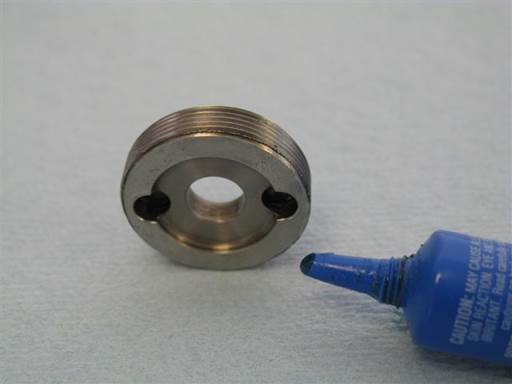
Once splined shaft bearing fit is assessed, and if needed adjustment performed, thread locker needs to be applied to splined shaft cover.
Remove splined shaft cover from splined shaft per above procedure.
Apply thread locker at middle of threads along perimeter of cover (high strength thread locker).
Reinstall splined shaft cover and fully tighten per above instructions.
For intake splined shaft, reinstall splined shaft stud O-ring.
Insert O-ring on splined shaft stud and roll O-ring down stud and drop into groove (fingers).
Installation of vanos seals and cleaning of parts
Follow Euro S50 double vanos procedure sections for installation of vanos seals and cleaning of parts, Euro S50 Double Vanos Procedure
Installation of splined shafts on vanos

Insert intake splined shaft stud fully into intake piston from vanos inboard side.
Brace piston end from vanos outboard side and insert splined shaft stud into piston.
Note: Insertion resistance is due to splined shaft stud O-ring.
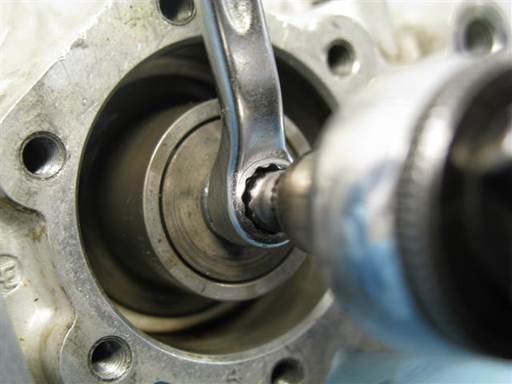

Install intake piston / splined shaft mounting nut.
Screw nut on splined shaft stud (fingers).
Counter hold piston/shaft by hand and screw nut (fingers, 7mm box wrench).
Note: Nut can only be slightly installed on shaft. This allows slight section of shaft stud to protrude from nut and allow counter holding shaft in next step.
Fully mount nut by counter holding nut and screwing on shaft stud (7mm box wrench, 4mm socket (6 point) 1/4″ / 1/4″ ratchet).
Note: At first, shaft tool (4mm socket) will only barely mount on splined shaft end.
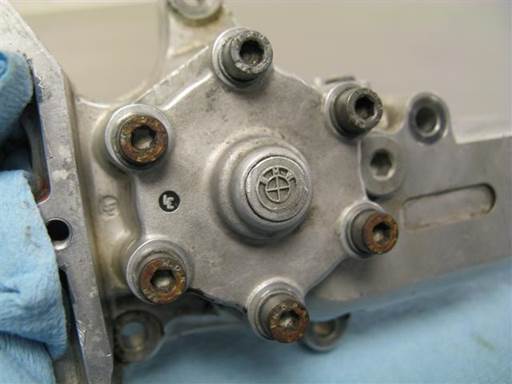
Install vanos intake cylinder cover.
Orient cover with side slight indent to vanos oil filter cap (picture right).
Initially install vanos intake cover 6 mounting bolts (4mm hex bit socket 3/8″).

Fully tighten intake cover 6 mounting bolts.
Tighten bolts evenly to draw cover evenly to vanos body.
Fully tighten, 5 Nm (4 ft-lb) (4mm hex bit socket 3/8″ / 3/8″ torque wrench).
Note: Tighten bolts evenly in multiple passes. Verify one pass with all bolts fully tightened.
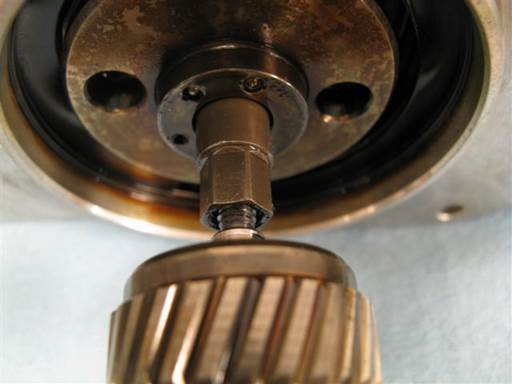
Install exhaust splined shaft onto exhaust piston.
Thread splined shaft stud into piston; left hand thread.
Note: Splined shaft stud and piston threads are left hand thread. Thus turn splined shaft stud counter clockwise to thread into piston thread.
Thread splined shaft stud fully into piston by rotating splined shaft stud; left hand thread (hand).
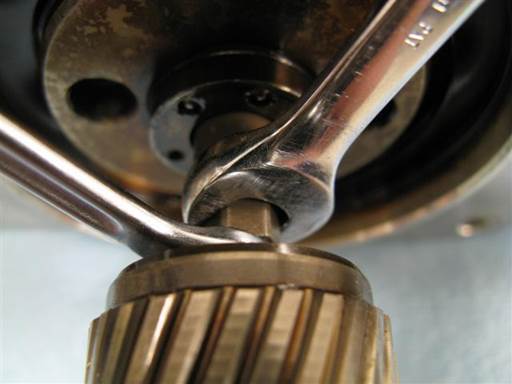
Tighten splined shaft stud to piston; left hand thread (10mm open wrench / 7mm open wrench).
Note: Due to left hand thread, it is not necessary to over tighten joint.
Installations of sprocket hubs
Remove and discard sprocket hubs old diaphragm springs and pressure plates.
Clean sprocket hubs (brake cleaner & towels).

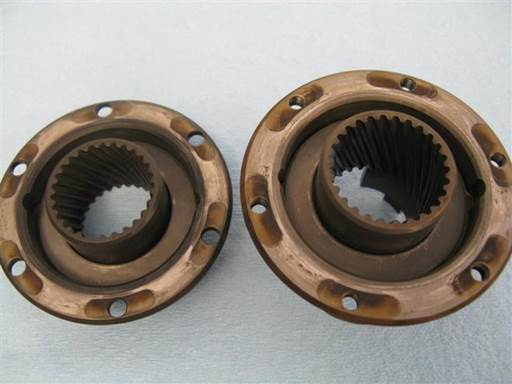
Install new diaphragm spring, cup side down, into each sprocket hub.

Install new pressure plate into each sprocket hub. Align pressure plate and hub keys.
Warning: Do not mix combine old and new diaphragm spring and pressure plate parts as dimensions have been changed.
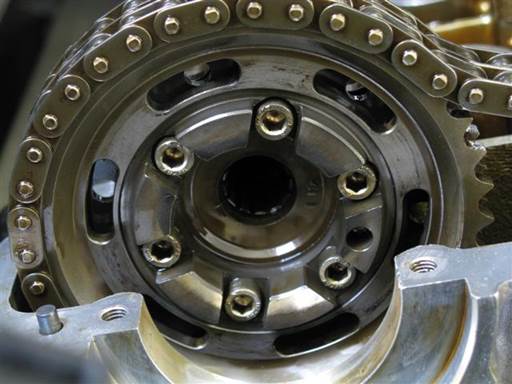
Verify exhaust sprocket left side slot orientation to engine head. Slot bottom end should be above head top surface (picture).
Rotate sprocket clockwise as needed to achieve orientation.
Note: Slot orientation is necessary in coming steps for installation of hub bolts.
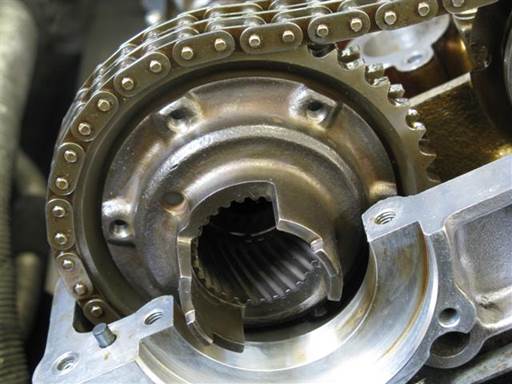
Install exhaust sprocket hub with new diaphragm spring and pressure plate onto exhaust sprocket.
Hold pressure plate on hub to keep from sliding of and dropping into engine.
Lift up sprocket with camshaft. Insert hub into sprocket sleeve. Lower sprocket and camshaft.
Note: Sprocket slot orientation might be disturbed. This is acceptable as it is checked and adjusted in future steps.
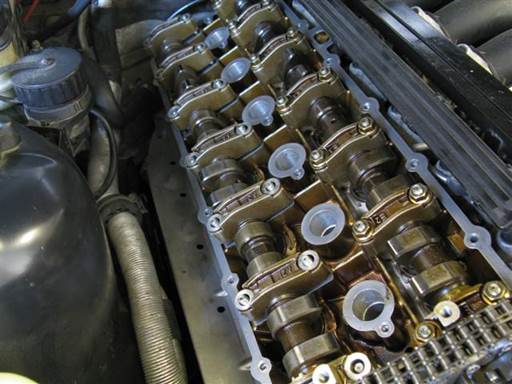
Verify and adjust exhaust camshaft as needed for cylinder 1 cams to point right and be horizontal as before (picture).
Install 7 exhaust camshaft bearing caps in their mounting locations. Note: Caps are numbered.
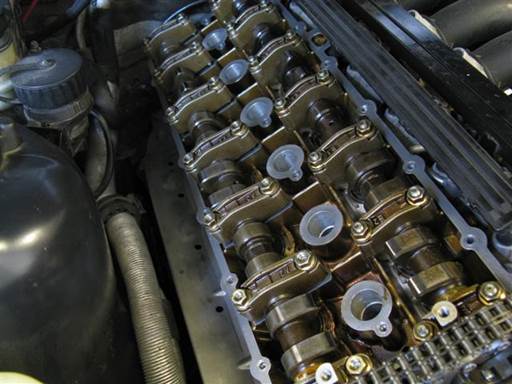
Install 14 exhaust bearing cap mounting nuts on cap studs with only one nut rotation.
Start at front and work to rear. Lift sprocket as needed to install rear cap nuts.

Slowly and evenly tighten 14 exhaust bearing cap mounting nuts (7 bearing caps) (13mm socket 3/8″ / 3/8″ ratchet).
Tighten nuts 1/4 to 1/2 turn each working back and forth along camshaft.
Ensure even nut tightening by noting threads on mounting nuts and studs. Assure even pressure on camshaft by tightening loose nuts.
Tighten nuts until all nuts are fully mounted.
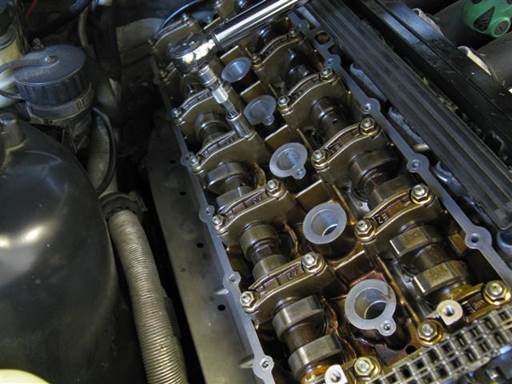
Fully tighten 14 exhaust bearing cap mounting nuts, 20 Nm (16 ft-lb) (7 bearing caps) (13mm socket 3/8″ / 3/8″ torque wrench & extension).
Note: Tighten nuts evenly in multiple passes. Verify one pass with all nuts fully tightened.

Rotate exhaust camshaft counter clockwise and position camshaft groove on first guide bearing to be roughly aligned with groove on first bearing cover (picture) (24mm open wrench).
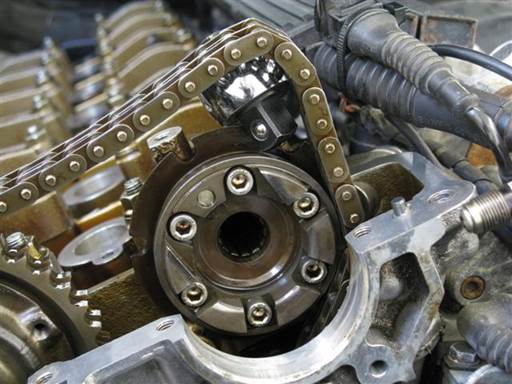
Hold exhaust sprocket to keep from rotating and lift chain at intake camshaft to take up all chain slack.
Place object between intake camshaft and chain to maintain chain tightness.
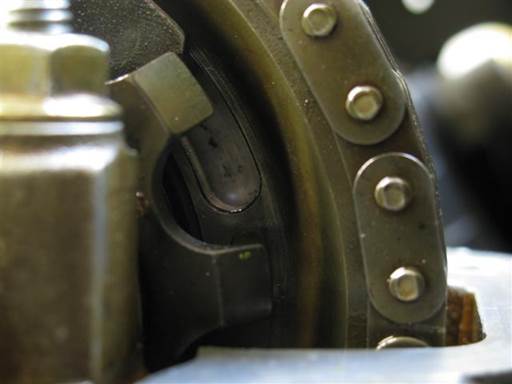
Rotate split ring at rear of exhaust sprocket to position split ring gap at camshaft tooth gap at right side (picture).
Note: Split ring gap positioning allows visual inspection of sprocket slot at location.
A sprocket slot end should be aligned ~1/4 up on tooth gap (picture).
Note: Sprocket slot orientation is needed for hub bolt access in future steps.
If sprocket slot end is not aligned to indicated position, rotate exhaust sprocket clockwise (car front orientation) to achieve slot alignment.
Remove chain tensioning object and feed chain down on right side of intake sprocket to allow exhaust sprocket clockwise rotation.
Position exhaust sprocket for slot positioning then tension chain again at intake sprocket and maintain with object as before.

Hold exhaust sprocket to keep from rotating and insert tool between exhaust sprocket and engine head to lock exhaust sprocket from rotating (medium flathead).
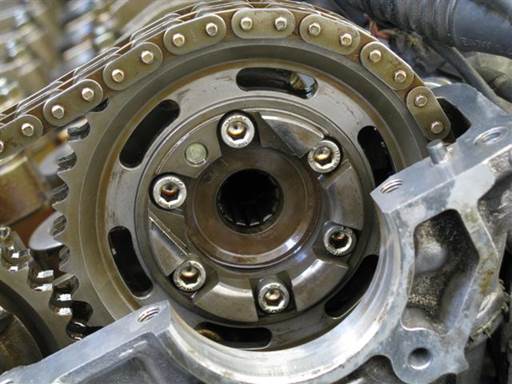
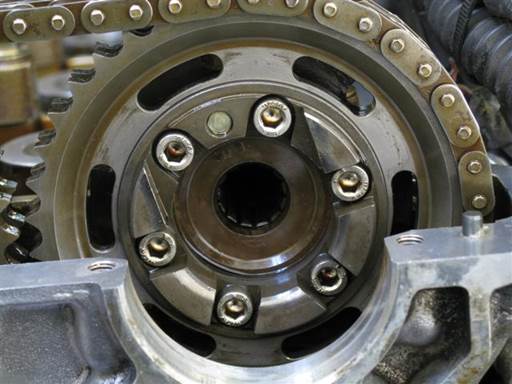
Install intake sprocket on intake camshaft sleeve.
Remove chain tensioning object.
Position sprocket for a slot bottom end to be approximately at head surface on left side (picture).
Install chain on sprocket and mount sprocket on camshaft sleeve.
Check sprocket slop positioning and reinstall sprocket as needed to achieve position.
Note: Sprocket slot orientation is needed for hub bolt access in future steps.

Remove exhaust sprocket holding tool (flathead).
Rotate exhaust sprocket counter clockwise (car front orientation) to position as if chain tensioner is installed.
Check sprocket slot at rear right of sprocket has slot end at bottom of camshaft tooth gap (picture).
If sprocket slot position not as indicated, remove intake sprocket and repeat above exhaust sprocket and intake sprocket positioning procedures.
Note: Sprocket slot orientation is needed for hub bolt access in future steps.
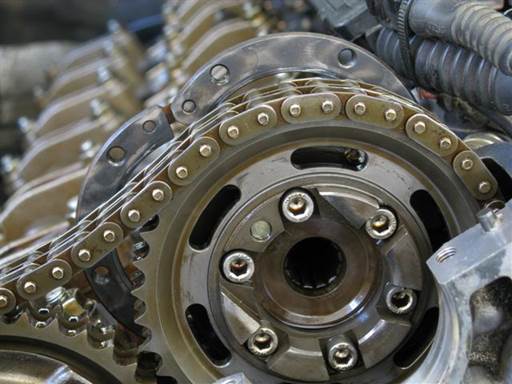
Install split ring at rear of intake sprocket.
Orient split ring with flat face to front. Open split ring and place at rear of intake sprocket with hinge at top.
Slide intake sprocket forward and install split ring at rear of intake sprocket.
Slide intake sprocket back on sprocket sleeve.
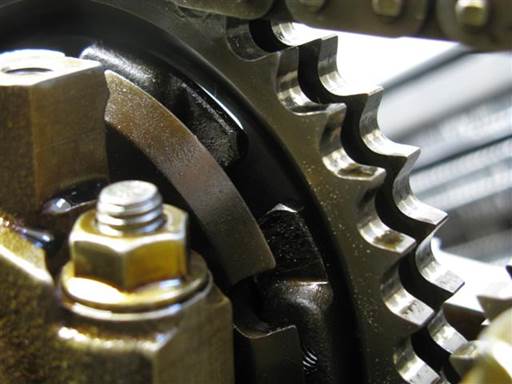
Rotate intake split ring to position split ring gap between two sprocket right side slots (sprocket rear orientation) (picture).
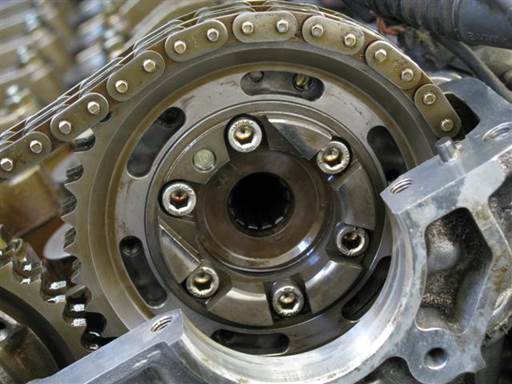
Adjust intake split ring slightly as needed to align bolt holes at sprocket slots (picture).
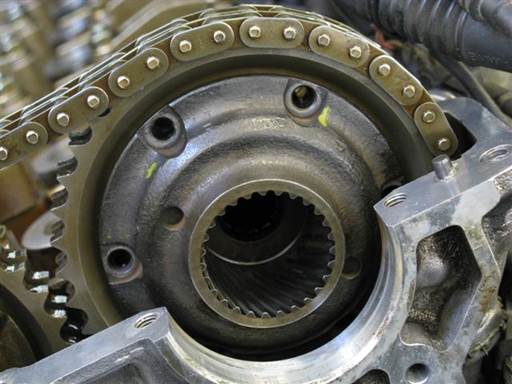
Install intake sprocket hub with new diaphragm spring and pressure plate onto intake sprocket.
Hold pressure plate on hub to keep from sliding of and dropping into engine.
Slide bub onto sprocket sleeve.
Rotate hub to align holes to split ring holes (picture).

Install 2 intake hub mounting bolts at hub top two mounting holes (picture) (5mm hex bit 3/8″ / 3/8″ extension).
Tighten bolts by hand then loosen approximately one rotation.
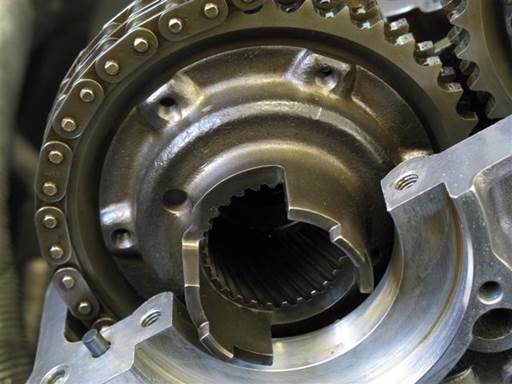
Rotate exhaust hub to orient hub tower tabs to be approximately at right and left side (picture).
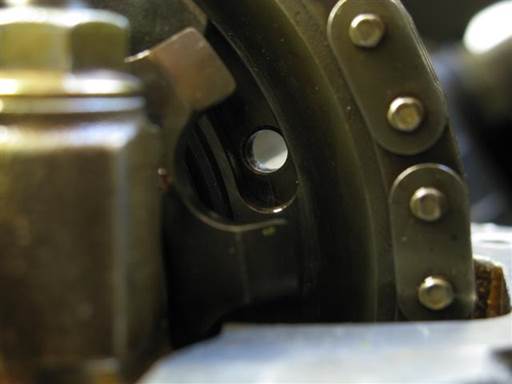
Slightly rotate exhaust hub to position hub bolt hole at center of camshaft right tooth gap (picture).
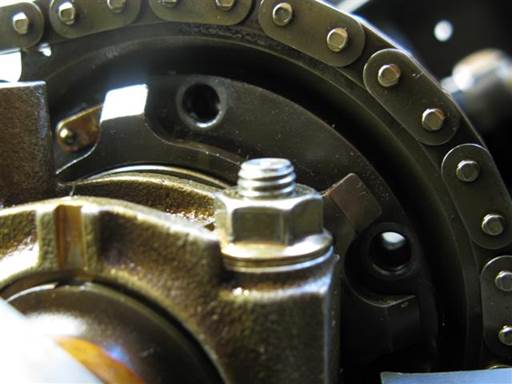
Rotate exhaust sprocket split ring to position hinge at left of top and align holes to hub holes (picture).

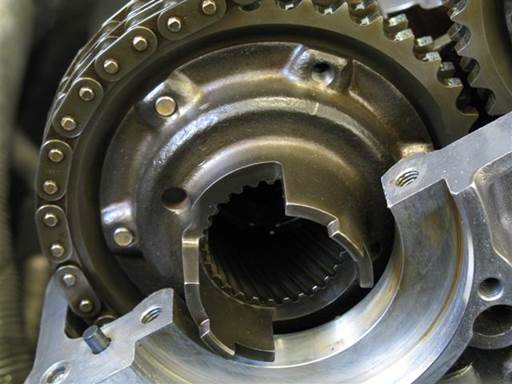
Install 2 exhaust hub mounting bolts at hub right side holes (sprocket rear orientation) (picture) (5mm hex bit 3/8″ / 3/8″ extension).
Rotate sprocket counter clockwise (car front orientation) to align sprocket slots with bolt holes.
Tighten bolts by hand then loosen approximately one rotation.

Install chain tensioner with new crush washer (32mm deep socket 1/2″ / 1/2″ long-arm ratchet).
Tighten tensioner a further ~1/2 turn after initial tightness to crush washer.
Installation of vanos with splined shafts
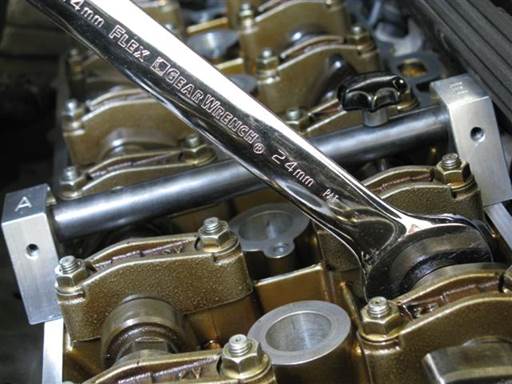
Install vanos alignment bridge without alignment dowel on engine head at cylinder 3 (picture).
Note: Bridge has intake and exhaust orientation. E is intake and A is exhaust in German.
Insert bridge alignment dowel through bridge intake side hole and insert dowel into intake camshaft alignment hole.
Note: Lift up bridge intake or exhaust ends as necessary to align and insert dowel into camshaft hole.
Rotate intake camshaft at hex at cylinder 2 to align camshaft alignment hole perpendicular to engine head and allow bridge ends to sit on engine head (24mm open wrench).
Fully insert bridge dowel into camshaft and onto bridge (picture). Turn and press down dowel as needed to fully insert.
Place hand on middle of bridge and rock intake camshaft back and forth to identify and set camshaft in position where bridge intake and exhaust ends are sitting flat on engine head.
Remove alignment dowel from bridge.
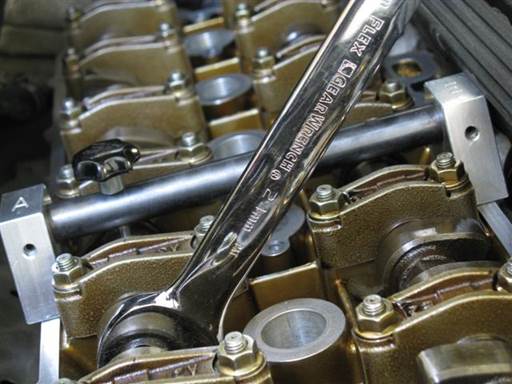
Insert bridge alignment dowel through bridge exhaust side hole and insert dowel into exhaust camshaft alignment hole.
Note: Lift up bridge intake or exhaust ends as necessary to align and insert dowel into camshaft hole.
Rotate exhaust camshaft at hex at cylinder 2 to align camshaft alignment hole perpendicular to engine head and allow bridge ends to sit on engine head (24mm open wrench).
Fully insert bridge dowel into camshaft and onto bridge (picture). Turn and press down dowel as needed to fully insert.
Place hand on middle of bridge and rock exhaust camshaft back and forth to identify and set camshaft in position where bridge intake and exhaust ends are sitting flat on engine head.
Remove alignment dowel from bridge. Remove bridge from engine head.

Move vanos ground wire forward and position end under vanos solenoid cable connector bracket.
Note: This allows installing vanos on engine head without ground wire being caught between vanos and engine head.

Rotate intake and exhaust sprocket hubs clockwise as far as possible (hand).

Insert vanos splined shafts with pistons fully into vanos.
Clean vanos all matting surfaces (brake cleaner & towels).


Install vanos with splined shafts onto sprocket hubs.
Align and initially insert exhaust and then intake spline shafts into corresponding hubs.
Align exhaust splined shaft to insert into exhaust camshaft hole at center of hub. Rotate and insert splined shaft to insert into camshaft.
Align intake splined shaft to insert into intake camshaft hole at center of hub. Rotate and insert splined shaft to insert into camshaft.
Press vanos onto engine to insert splined shafts into camshafts and bring splined shafts slanted splines up to hubs.
Vanos press will also reinsert splined shafts and pistons fully into vanos if they came out.

Insert exhaust splined shaft slanted splines into exhaust hub.
Rotate exhaust hub counter clockwise while pressing vanos onto hub.
Splined shaft will insert into hub at first alignment of splines.
Caution: Splined shaft must insert into first available aligned hub splines.

Insert intake splined shaft slanted splines into intake hub.
Rotate intake hub counter clockwise while pressing vanos onto hub.
Splined shaft will insert into hub at first alignment of splines.
Caution: Splined shaft must insert into first available aligned hub splines.

Press vanos onto engine head and splined shafts will insert further into hubs.
Do not fully install vanos onto engine head.

Inspect vanos oil pump side hole and exhaust sprocket hub side tab for alignment.
Rotate vanos oil pump as needed to achieve alignment (fingers).

Press vanos onto engine head and verify exhaust hub tab insertion into vanos oil pump hole.
Realign vanos pump as need to facilitate tab insertion (fingers).

Install vanos bottom right and left mounting bolts to fully install vanos onto engine head (5mm hex bit 3/8″ / 3/8″ ratchet).
Tighten bolts evenly in multiple passes to install vanos on engine head evenly.
Tighten bolts until fully mounted. Do not over tighten.

Tighten 2 intake hub mounting bolts (5mm hex bit 3/8″ / 3/8″ ratchet & extension).
Note: Do not over tighten bolts. Bolts will be fully tightened in second pass.

Tighten 2 exhaust hub mounting bolts (5mm hex bit 3/8″ / 3/8″ ratchet & extension).
Note: Do not over tighten bolts. Bolts will be fully tightened in second pass.

Remove crankshaft locking pin.

Rotate crankshaft until next two intake hub mounting holes are in accessible position as before (picture).

Install 2 exhaust hub mounting bolts (5mm hex bit 3/8″ / 3/8″ ratchet & extension).
Adjust crankshaft rotation as needed to align mounting holes for access as before (picture).
Note: Be careful to not drop bolts in engine.
Tighten bolts evenly in multiple passes until tight.
Note: Do not over tighten bolts. Bolts will be fully tightened in second pass.

Install 2 intake hub mounting bolts (5mm hex bit 3/8″ / 3/8″ ratchet & extension).
Adjust crankshaft rotation as needed to align mounting holes for better access (picture).
Note: Be careful to not drop bolts in engine.
Tighten bolts evenly in multiple passes until tight.
Note: Do not over tighten bolts. Bolts will be fully tightened in second pass.

Rotate crankshaft until next two intake hub mounting holes are in accessible position as before (picture).

Install 2 exhaust hub mounting bolts (5mm hex bit 3/8″ / 3/8″ ratchet & extension).
Adjust crankshaft rotation as needed to align mounting holes for access as before (picture).
Note: Be careful to not drop bolts in engine.
Tighten bolts evenly in multiple passes until tight.
Note: Do not over tighten bolts. Bolts will be fully tightened in second pass.

Install 2 intake hub mounting bolts (5mm hex bit 3/8″ / 3/8″ ratchet & extension).
Adjust crankshaft rotation as needed to align mounting holes for better access (picture).
Note: Be careful to not drop bolts in engine.
Tighten bolts in multiple passes until tight.
Note: Do not over tighten bolts. Bolts will be fully tightened in second pass.
Repeat above procedure of rotating crankshaft to access two sets of intake and exhaust hub bolts at a time and fully tighten all 6 intake and exhaust hub bolts to 10 Nm (7 ft-lb).
Checking of engine timing

Turn crankshaft pulley clockwise until cylinder 1 intake and exhaust cams point to each other at ~45 degree angle (crankshaft turning socket / 1/2″ long-arm ratchet).
Note: Turning crankshaft counter clockwise is acceptable.

Adjust crankshaft slightly until timing marks on engine timing cover and crankshaft harmonic balancer at ~11 o”clock position are aligned (crankshaft turning socket / 1/2″ long-arm ratchet, mirror).
Precisely alignment timing marks. This will align sensor bracket hole and harmonic balancer hole (picture).

Insert crankshaft locking pin into sensor bracket hole and harmonic balancer hole.


Fully retard intake and exhaust camshafts.
For each camshaft, place open wrench (24mm combo wrench) on camshaft hex at cylinder 2 and turn camshaft counter clockwise to adjustment end position.
Note: Camshaft rotation is most effective when standing at exhaust side of car.
Note: Rock camshaft back and forth to release bind and allow rotation.
Note: Camshafts will already be close to fully retarded position.

Install vanos alignment bridge without alignment dowel on engine head at cylinder 3 (picture).
Note: Bridge has intake and exhaust orientation. E is intake and A is exhaust in German.
Insert bridge alignment dowel through bridge intake side hole and insert dowel into intake camshaft alignment hole.
Note: Lift up bridge intake or exhaust end as necessary to align and insert dowel into camshaft hole.
Fully insert dowel into camshaft and onto bridge (picture). Rotate and press down dowel as needed to fully insert.
Bridge intake and exhaust ends should be sitting flat on engine head. Press down on each end to assess any space between bridge end and head surface.
Timing is wrong if bridge end is lifted from engine head more than .5mm.
Remove alignment dowel from bridge.

Insert bridge alignment dowel through bridge exhaust side hole and insert dowel into exhaust camshaft alignment hole.
Note: Lift up bridge intake or exhaust end as necessary to align and insert dowel into camshaft hole.
Fully insert dowel into camshaft and onto bridge (picture). Rotate and press down dowel as needed to fully insert.
Bridge intake and exhaust ends should be sitting flat on engine head. Press down on each end to assess any space between bridge end and head surface.
Timing is wrong if bridge end is lifted from engine head more than .5mm.
Remove alignment dowel from bridge then bridge from engine head.

Remove crankshaft locking pin.

Install chain guide.
Slide guide onto chain and mount with 2 mounting bolts (11mm socket 3/8″ / 3/8″ ratchet).
Fully tighten, 14 Nm (10 ft-lb) (11mm socket 3/8″ / 3/8″ torque wrench).

Remove vanos bottom right and left mounting bolts (5mm hex bit 3/8″ / 3/8″ ratchet).
Pull vanos forward and off engine head.
Caution: It is critical vanos oil pump rotation position not be changed. Otherwise damage can occur.
Continue repair following Euro S50 double vanos procedure, Euro S50 Double Vanos Procedure
Start at step of applying sealant to vanos bridge bottom and installing vanos bridge.
© 2024 Beisan Systems LLC

